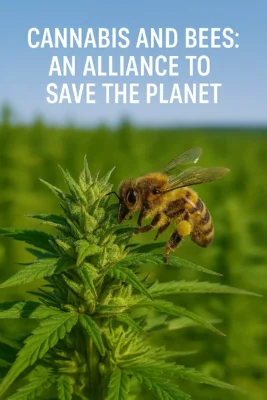Introduction
In the context of growing environmental concerns and the transition to renewable energy sources, industrial hemp is emerging as a versatile and sustainable resource. Historically used for textiles and materials, this plant now holds extraordinary potential in the field of bioenergy. From biofuels to biomass, hemp represents an innovative solution to reduce environmental impact and address global energy challenges.
In this article, we will explore how hemp can be utilized to produce clean and renewable energy, analyzing its benefits, the technologies involved, and future prospects.
The Potential of Hemp in Bioenergy
Hemp is an extraordinary plant, known for its rapid growth and ability to thrive in various climates and soils. In addition to being eco-friendly, it is particularly suited for energy production due to its cellulose-rich biomass.
Bioenergy sources from hemp:
- Biofuels (Bioethanol and Biodiesel):
- Bioethanol can be extracted from hemp fibers through fermentation.
- Hemp seeds, rich in natural oils, can be transformed into biodiesel through esterification processes.
- Biomass for thermal and electric energy production:
- Hemp biomass can be used in cogeneration plants to produce heat and electricity.
- Fermentation gas (Biogas):
- Anaerobic digestion of the plant’s unused parts can generate methane, a versatile combustible gas.
Advantages of Hemp in Bioenergy Production
-
Environmental sustainability:
Hemp grows quickly and absorbs large amounts of CO₂ during its life cycle, helping to reduce greenhouse gas emissions. -
Low competition with food crops:
Unlike other energy crops like corn, hemp doesn’t compete for arable land as it grows even on marginal soils. -
Soil regeneration:
Growing hemp not only produces energy but also helps regenerate degraded soils, improving their quality with its deep roots. -
Quick cultivation cycle:
Hemp is ready for harvest in just 3-4 months, enabling continuous biomass production throughout the year.
Technologies for Converting Hemp into Energy
-
Bioethanol Extraction:
The cellulose in hemp stalks is broken down into simple sugars through enzymatic processes, which are then fermented to produce bioethanol. -
Biodiesel Production:
Oil extracted from hemp seeds is treated with alcohol and a catalyst to produce biodiesel, an eco-friendly fuel that can replace traditional diesel. -
Biomass Conversion:
Waste from hemp processing can be pressed into pellets or briquettes for use as fuel in heating systems. -
Anaerobic Digestion:
Organic residues from hemp can generate biogas through anaerobic digestion, which can power electric generators or heating systems.
Practical Applications of Hemp Bioenergy
-
Sustainable transportation:
Biofuels derived from hemp can power vehicles, reducing dependence on fossil fuels. -
Energy for homes:
Hemp biomass is an economical solution for providing heating and electricity in rural areas. -
Agricultural support:
Farmers can integrate hemp production to diversify income streams and contribute to environmental sustainability.
Challenges and Future Prospects
Despite its great potential, there are challenges to fully utilizing hemp for bioenergy:
- Regulations: Many countries have restrictive laws on hemp cultivation, limiting its spread.
- Infrastructure: Converting hemp into energy requires investments in advanced technologies.
- Awareness: The potential of hemp remains underappreciated among consumers and investors.
However, with proper policies and a growing interest in renewable sources, hemp could become a cornerstone in the global energy transition.
Conclusion
Industrial hemp is an incredibly versatile and sustainable resource for the future of bioenergy. From bioethanol to biogas, this plant offers concrete solutions to reduce environmental impact, regenerate soils, and promote a greener economy.
Investing in research and promoting hemp as a renewable energy source will not only improve energy self-sufficiency but also create a more sustainable world for future generations.
🌱 Hemp is not just a plant; it is a key to the future of energy.



